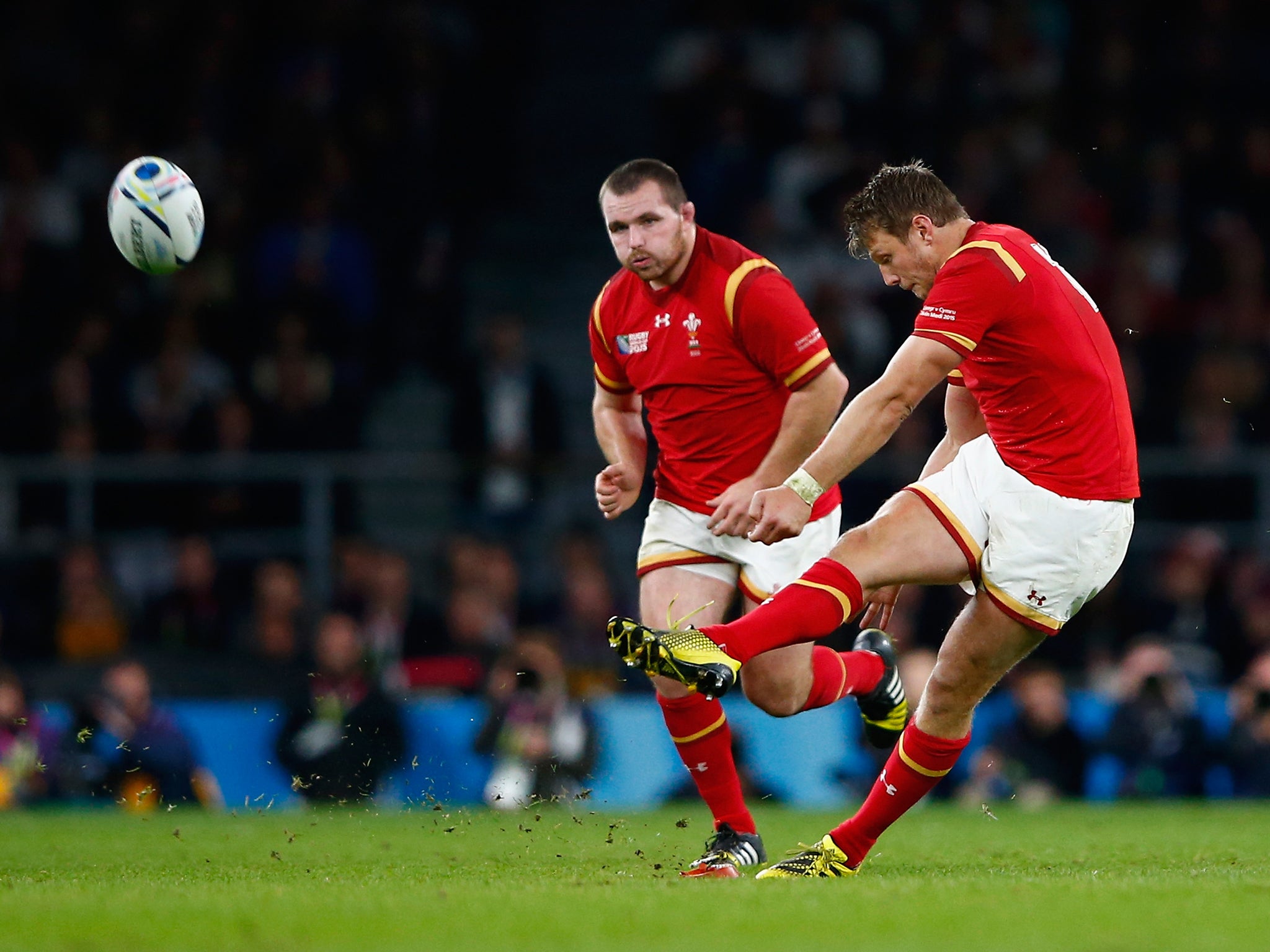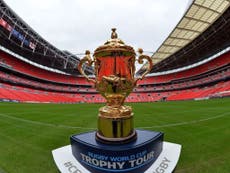Royals, religion, rugby: the three Rs of British unity – and division
We are in the midst of a patriotic pantomime, heraldic beasts and symbolic harps fluttering on banners across the stadiums of England


In the Welsh tales of The Mabinogion, a semi-divine warrior called Mabon ap Modron escapes bondage to join a band of comrades who assault and conquer the castle of a mighty ogre. Connoisseurs of medieval story-cycles might have felt an atavistic shiver last Saturday, as the invincible boot of Wales’s fly-half Dan Biggar humbled England in their Twickenham citadel.
For more than a century, rugby rivalry has both divided and united the four nations of the British Isles in a much more even contest – a less sloping pitch, if you prefer – than any other sport. The World Cup has, so far, lived up to this levelling tradition, with Wales striking an epic blow on the hearth of its giant neighbour. Cue a bout of patriotic frenzy seldom seen since the triumphs of Owain Glyndwr.
These days, intra-British clashes reveal plenty of gusto but not so much grudge. In the years before corporate cash sanitised top-flight sport, however, “home nations” fixtures had more of a dangerous edge. Between 1872 and 1989 (when the regular matches ended), the annual meeting between the football teams of England and Scotland hardly counted – in Orwell’s phrase – as war minus the shooting. It sometimes looked like war by strictly military means. In insurgent Ireland, a stadium witnessed not a metaphorical but an actual massacre when in 1920 the Royal Irish Constabulary and British auxiliaries murdered 13 spectators and a player during the Dublin-Tipperary Gaelic football match.
Now, the Queen can visit Croke Park (as she did in 2011) with few murmurs of dissent. With the SNP hegemonic at Holyrood and at battalion strength at Westminster, the national question within the United Kingdom has no need for surrogate arenas overloaded with seething, displaced resentment. Now, we can all supposedly debate the pros and cons of solidarity and secession like grown-ups, and treat cultural or sporting antagonisms as play-fights with the power to thrill but not to kill. An England-Ireland rugby showdown would cause the beer but not the blood to flow – but remember, though, that only this June fears of inflammatory chanting by visiting supporters preceded a similar soccer fixture in Dublin. In the event, death from acute tedium proved a graver risk.
In games, in arts, in folklore, the cultivation of difference – even of antipathy – between the nations of the UK has done many different jobs. For every needle match that seems to dig a deeper trench between the peoples of these isles, another field of rivalry has seen good-natured pluralism bury the bones of contention. Wales today proves the point. In May’s general election, Plaid Cymru achieved no more than a standstill vote: 12 per cent, a fractional rise on 2010. The “Party of Wales” won the same three seats as before. Most remarkably, it even trailed behind Ukip among Welsh voters: 12.1 to 13.6 per cent.
From music and poetry to sport, “Celtic” styles and motifs may have had as much of an adhesive as a corrosive effect on the multinational British state. Go along to Celts: Art and Identity, the British Museum’s myth-busting new exhibition, and you will see that the champions of Welsh, Scottish and even Irish distinctiveness have saluted as well as subverted the UK status quo. About two-thirds of the show displays gorgeous, mysterious artworks made over a span of two millennia by the miscellany of communities we call Celts. As the curators insist, “there is no single history, no single people”, and “we strain the word ‘Celtic’ if we stretch it too far”. Besides, it cuts through the mists of sentiment to realise that some of the grandest artefacts – horned helmets, ornamented bowls, embossed shields – come from such romantic backwaters of the ancient world as Battersea and Waterloo. Local tribes liked to propitiate their gods by chucking treasures into the muddy Thames.
The eerie, even sinister, beauty of Celtic art has no need of political fantasies to prove its worth. However, when the BM narrative moves to Celtic revivalism, the shape-shifting ambivalence of this rich legacy comes to the fore. Over the UK’s four nations, the “Celtic” inheritance has all the clarity of one of Merlin’s riddling prophecies. Look, for instance, at the murals of Ulster’s mythical hero Cuchulainn painted on the walls of divided Belfast. Both loyalists and nationalists picture him: the former as a local champion of Ulster, the latter as a native hero for all Ireland. His outsize reputation cuts both ways.
It must be significant that the Welsh scholar Edward Lhuyd first grouped the speakers of Celtic languages together, and located them in the British Isles and Brittany alone, in 1707. In that year, Scotland forfeited its parliamentary sovereignty in the Act of Union. The stronger the centre, the fancier the fringe.
In 1822, Sir Walter Scott masterminded the visit of George IV to Scotland: the first by a British monarch since the Restoration. A jamboree of “traditional” Highland pageantry (some authentic, most fake) accompanied the king as he progressed around Edinburgh to weather-proof the Union. Then, tartanry meant loyalty. Almost two centuries later, Andrew Marr – that latest incarnation of the gifted “lad o’pairts” who does well in London – is about to publish a panoramic survey of the verse of these islands to coincide with National Poetry Day. Although he puts many Scots writers centre stage, Marr has chosen to call his book We British – a title which, he mischievously knows, will go down like a concrete kite in some quarters. He closes with the poem that, wearing her Laureate’s bonnet, Carol Ann Duffy wrote after the independence referendum last September: “A thistle can draw blood,/ so can a rose,/ growing together/ where the river flows, shared currency/ across a border it can never know.”
Separatist politicians may stumble when they try to cash in that “shared currency” of contiguous memories. The SNP, at least, has learnt the lessons of the treacherously twilit Celtic past. The party’s breakthrough came after it ditched sectarian dogma to forge a modern civic nationalism in which the pseudo-ethnic pieties of blood and soil would play no part. Even if mystic or nostalgic nationhood holds some charms for the rank and file, the mainstream SNP has in its ascent neutralised the rage and romance of the “Celtic” tradition.
Neither in Scotland nor in Wales have politicians proved able to weaponise that legacy into an effective armament. Too often, the missile of traditional identity either backfires or fragments. Ireland is a separate case. There, a truly revolutionary movement did grow out of a cultural awakening. Within a decade, in the 1900s, Gaelic summer schools, dance classes and drama clubs yielded to gun-running, military drills and – at Easter 1916 – violent insurrection against the British empire. Roy Foster, the nonpareil historian of modern Ireland, charts this transition among the “revolutionary generation” in his book Vivid Faces.
It was an extraordinary wave of what we would now label “radicalisation”. Middle-class hobbyists swiftly passed from antiquarian scholarship and folkloric kitsch to “the cult of the gun”. When open warfare broke out on the streets of Dublin, “several people mistook the manoeuvres for street theatre”. Suddenly, that impractical, arty crowd had real rifles in their hands.
Even in Ireland, though, the Celtic uniform helped to unify as well as to divide. Many leading revolutionaries came from a Protestant background. That cult of the Celtic twilight served to fudge and bridge a potential chasm between them and the Catholic majority. After partition, the all-Ireland dream did not quite fade away. Notably, it endured on the rugby pitch. Ireland has always fielded a united team. In 1995, the Irish rugby union even commissioned a special anthem for away matches from the songwriter-producer Phil Coulter, “Ireland’s Call”. It was meant to put an end to niggly precedence disputes between “God Save the Queen” and “The Soldier’s Song”.
Should a second referendum come with independence in its wake, the Scots will learn from Ireland that statehood alone cannot (and should not) foster any sort of cultural unanimity. Next year, the republic faces a tricky hurdle as it commemorates the centenary of the Easter Rising. Its government has, bravely, played a high symbolic card in the choice of an arts minister to oversee this contested carnival of remembrance. She is Heather Humphreys, a “proud Irish republican”, but also a Protestant and an Ulsterwoman from Co Monaghan.
As heraldic beasts and symbolic harps flutter on banners across the stadiums of England, non-combatants could draw two lessons from this four-nations patriotic pantomime. First, the celebration of a non-English or even anti-English “Celtic” identity leads down no predetermined political pathway. It may seal as often as it splits.
The second, in Ireland now or Scotland in the near future, is that full-dress statehood will still leave modern nations with a full plate of identity-and-diversity questions to chew over at their leisure. The Catalans, who last weekend voted a separatist majority into their legislature, have discovered that. On pitches or in parliaments, secessionists and unionists alike should recall a line from Seamus Heaney, that supreme advocate of heritage without hatred. As he wrote in “The Harvest Bow”, “The end of art is peace.” And, perhaps, of sport as well – although, just now, England rugby fans may disagree.



Join our commenting forum
Join thought-provoking conversations, follow other Independent readers and see their replies